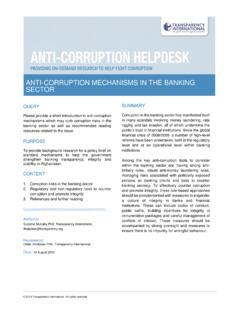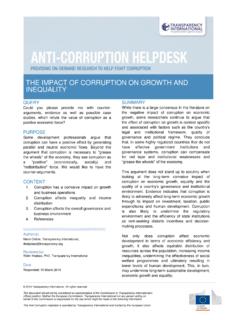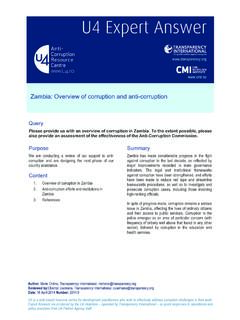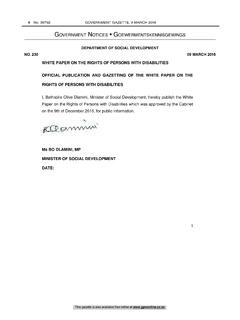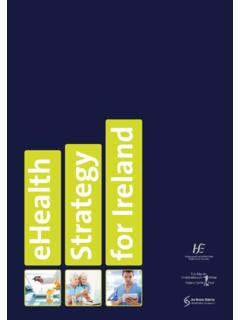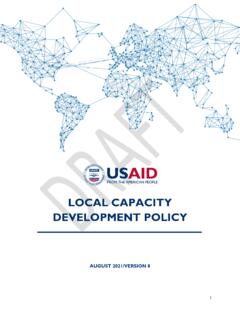Transcription of PUBLIC FINANCIAL MANAGEMENT TOPIC GUIDE
1 PUBLIC FINANCIAL MANAGEMENT TOPIC GUIDE COMPILED BY THE ANTI-CORRUPTION HELPDESK Transparency International is a global movement with one vision: a world in which government, business, civil society and the daily lives of people are free of corruption. Through more than 100 chapters worldwide and an international secretariat in Berlin, we are leading the fight against corruption to turn this vision into reality. TOPIC guides are a series of publications developed by the Anti-Corruption Helpdesk on key corruption and anti-corruption issues. They provide an overview of the current anti-corruption debate and a list of the most up to date and relevant studies and resources on a given TOPIC . Authors: Matthias Morgner, Marie Ch ne Reviewer(s): Finn Heinrich, PhD Date: 28 November 2014 2014 Transparency International. All rights reserved. This document should not be considered as representative of the European Commission or Transparency International s official position.
2 Neither the European Commission, Transparency International nor any person acting on behalf of the Commission is responsible for how the following information is used. With support from the European Commission TABLE OF CONTENTS TABLE OF CONTENTS 1 CORRUPTION RISKS IN PUBLIC FINANCIAL MANAGEMENT : AN OVERVIEW 2 WHAT IS PUBLIC FINANCIAL MANAGEMENT ? 2 CORRUPTION RISKS IN PFM 2 PFM REFORMS AND ANTI-CORRUPTION 4 GENERAL RESOURCES ON PUBLIC FINANCE MANAGEMENT 5 THE BUDGET PROCESS 13 BUDGET FORMULATION 13 BUDGET APPROVAL 14 BUDGET EXECUTION 15 RESOURCES ON THE BUDGET PROCESS 17 TAX ADMINISTRATION 23 OVERVIEW OF KEY ISSUES 23 OPPORTUNITIES FOR CORRUPTION 23 ANTI-CORRUPTION MEASURES AND APPROACHES 24 THE ROLE OF DONORS 25 RESOURCES ON TAX ADMINISTRATION 26 PUBLIC PROCUREMENT 31 CORRUPTION RISKS IN PUBLIC PROCUREMENT 31 ANTI-CORRUPTION TOOLS AND APPROACHES 32 RESOURCES ON PUBLIC PROCUREMENT 34 QUASI-FISCAL OPERATIONS AND OFF-BUDGET FUNDS 43 OVERVIEW OF CORRUPTION RISKS 43 ANTI-CORRUPTION TOOLS AND APPROACHES 44 RESOURCES ON EXTRA-BUDGETARY FUNDS 45 EXTERNAL AUDIT AND OVERSIGHT 50 SUPREME AUDIT INSTITUTIONS 50 ANTI-CORRUPTION TOOLS AND APPROACHES 51 LEGISLATIVE OVERSIGHT 51 ANTI-CORRUPTION TOOLS AND APPROACHES 52 RESOURCES ON EXTERNAL AUDIT AND OVERSIGHT 53 Each part of this
3 TOPIC GUIDE provides an overview of major corruption risks and anti-corruption approaches, and a compilation of the most up to date and relevant studies and resources on the TOPIC . 2 TRANSPARENCY INTERNATIONAL CORRUPTION RISKS IN PUBLIC FINANCIAL MANAGEMENT : AN OVERVIEW WHAT IS PUBLIC FINANCIAL MANAGEMENT ? PUBLIC FINANCIAL MANAGEMENT (PFM) is a central element of a functioning administration, underlying all government activities. It encompasses the mechanisms through which PUBLIC resources are collected, allocated, spent and accounted for. As such, PFM processes comprise the whole budget cycle, PUBLIC procurement, audit practices and revenue collection. Sound, transparent and accountable PUBLIC FINANCIAL MANAGEMENT is a key pillar of governance reform and of vital importance to provide PUBLIC services of good quality to citizens, as well as to create and maintain fair and sustainable economic and social conditions in a country.
4 CORRUPTION RISKS IN PFM PFM involves highly complex, technical tasks and processes, including macroeconomic forecasting, budget allocation, accounting and auditing. The complexity of such processes limits PUBLIC scrutiny and provides many opportunities for corruption. The risk of corruption varies between and within the different stages of the budget process. Although corruption primarily manifests itself in forms that involve illegal money transfers at the budget execution level, other steps of the budget process may create opportunities for corruption at other stages of the PFM process1. Budget formulation. The government forecasts expected revenue and expenditure and plans the use of resources based on policy priorities. At this stage of the budget process, it possible to prepare for future embezzlement by planning the allocation of resources according to biased criteria. Corruption can take the form of political corruption, using discretionary budgetary powers to give preferential treatment to certain groups or to allocate budget resources to projects or areas based on political affiliations or rent-seeking opportunities.
5 Budget approval. The budget is debated and approved by the legislature. At this stage of the process, corrupt parliamentarians, backed by political parties or businesses, may deliberately amend the budget proposal to set funds aside for later misuse or to secure favourable treatment for their constituencies. Special interest groups may also unduly influence parliamentarians to overturn the proposed budget, or to safeguard an allocation or 1 The budget process and corruption. Isaksen, J., 2005. U4 Issue 2005:3. Bergen: Chr. Michelsen Institute. See more at: # 3 PUBLIC FINANCE MANAGEMENT TOPIC GUIDE subsidies. The risk of lobbying growing beyond PUBLIC control and leading up to state-capture is especially high in this stage of the PFM process. Budget execution. Resources approved at the budget formulation stage are disbursed to pay the salaries of PUBLIC servants, running costs of the administration, provision of PUBLIC goods and services to citizens, PUBLIC works and infrastructure, debt MANAGEMENT , and so on.
6 Budget execution also covers the collection of taxes, duties, and fees. This stage of the process is the most vulnerable to corruption as the money becomes tangible and a large number of individuals are involved with monetary transactions in various ministries and PUBLIC institutions and at various levels of the administration. Corruption can manifest itself in various forms, including bribery, kickbacks, embezzlement and theft. In particular, PUBLIC investment projects can be distorted, both in size and in composition, for rent-seeking purposes. Bribery and kickbacks in PUBLIC procurement, bid-rigging and other forms of undue advantages to certain providers of services, goods and works are also common forms of corruption at this stage of the process. The tax and customs administrations may also be misused to pursue rent-seeking and corrupt practices. Money can be stolen or used for expenditures which benefit certain individuals and their business or political allies.
7 Accounting and reporting. Together with disbursing or collecting money, spending agencies record and account for their expenditures or revenues collected. FINANCIAL reports are subject to internal audits to ensure that the rules and regulations at the department or ministerial level, in terms of procurement processes, contract MANAGEMENT and other basic requirement, have been enforced. FINANCIAL reports from spending agencies are later centrally consolidated by the Ministry of Finance which issues a report to show how the budget has been implemented and which is subject to external oversight. Weak, flawed or opaque reporting and accounting practices are likely to increase the corruption risk at other stages of the execution process, by reducing the chances of corruption to be adequately prevented and detected. Turning a blind eye, or allowing for creative accounting to cover corruption schemes may also be done deliberately.
8 Extra-budgetary funds. Extra-budgetary accounts for specific types of expenditure or revenue are common in many countries. While they may be set up for legitimate purposes (pension and social security funds, or stabilisation or reserve funds managing surplus revenue from, for example, the sale of natural resources), their implementation, control and oversight is often not subject to similar PFM standards and instruments than on-budget funds. Some off-budget funds may be set up to reduce the political and administrative controls that typically regulate budgetary spending. Extra-budgetary accounts can represent an important share of government expenditures and the relative lack of scrutiny over these funds may provide many opportunities for corruption. External oversight. External audits are typically undertaken by supreme audit institutions (SAIs) who have the mandate to ensure the accountability of PUBLIC funds in general.
9 Legislative oversight is normally ensured by the parliamentary PUBLIC accounts committee. The budget execution of the executive is endorsed in a parliamentary debate and becomes the legal basis for the work of the government for the future period. Limited legislative scrutiny, lack of resources, capacity and leverage, and poor executive follow up are likely to 4 TRANSPARENCY INTERNATIONAL hamper external oversight of PUBLIC accounts. However, in recent years, parliaments, civil society and donors have shown an increased commitment to participate in the process and strengthen external oversight. PFM REFORMS AND ANTI-CORRUPTION PFM reforms have typically focused on achieving and securing overall economic and fiscal stability, allocative efficiency and operational efficiency2. To this end, PFM reforms mostly prioritise technical approaches to improve the performance of the PFM systems, including through the integration, modernisation and automation of PFM processes, revenue collection, PUBLIC expenditure MANAGEMENT and procurement systems.
10 They traditionally include measures aimed at streamlining budget processes, supporting revenue administration, improving procurement processes and strengthening external oversight. While these reforms are not primarily aimed at curbing corruption, there is a broad consensus that they can help prevent and detect misuse of PUBLIC resources through streamlined processes, increased transparency and stronger oversight. Recent trends in PFM reforms call for moving beyond technical reforms and paying more attention to transparency, accountability and PUBLIC participation in PFM. Global initiatives, such as the Open Government Partnership, the Global Initiative for Fiscal Transparency (GIFT) and the International Budget Partnership, are working for this purpose. Traditional PFM reform promoters like the World Bank, IMF, OECD, regional development banks and bilateral donors are also updating their standards, benchmarks and principles to put more emphasis on transparency, accountability and PUBLIC participation in PFM.


